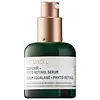What's inside
What's inside
 Key Ingredients
Key Ingredients

 Benefits
Benefits

 Concerns
Concerns

 Ingredients Side-by-side
Ingredients Side-by-side

Water
Skin ConditioningSqualane
EmollientNiacinamide
SmoothingSodium Acrylates Copolymer
Bakuchiol
AntimicrobialSodium Hyaluronate
HumectantRosa Canina Fruit Oil
EmollientCitrus Aurantium Amara Peel Oil
Skin ConditioningBiosaccharide Gum-1
HumectantYeast Extract
Skin ConditioningSoy Amino Acids
Skin ConditioningLecithin
EmollientHexylene Glycol
EmulsifyingEthylhexylglycerin
Skin ConditioningCaprylyl Glycol
EmollientPhenoxyethanol
PreservativeTetrasodium Glutamate Diacetate
Citric Acid
BufferingLinalool
PerfumingGeraniol
PerfumingLimonene
PerfumingWater, Squalane, Niacinamide, Sodium Acrylates Copolymer, Bakuchiol, Sodium Hyaluronate, Rosa Canina Fruit Oil, Citrus Aurantium Amara Peel Oil, Biosaccharide Gum-1, Yeast Extract, Soy Amino Acids, Lecithin, Hexylene Glycol, Ethylhexylglycerin, Caprylyl Glycol, Phenoxyethanol, Tetrasodium Glutamate Diacetate, Citric Acid, Linalool, Geraniol, Limonene
Water
Skin ConditioningDimethicone
EmollientPentaerythrityl Tetraisostearate
EmollientIsononyl Isononanoate
EmollientButylene Glycol
HumectantBakuchiol
AntimicrobialArachidyl Alcohol
EmollientGlyceryl Polymethacrylate
Dimethicone Crosspolymer
Emulsion StabilisingBehenyl Alcohol
EmollientGlycerin
HumectantPEG-75 Shea Butter Glycerides
EmulsifyingGlyceryl Stearate
EmollientC12-15 Alkyl Benzoate
AntimicrobialPolysorbate 20
EmulsifyingTetrahexyldecyl Ascorbate
AntioxidantRetinol
Skin ConditioningCeramide Ng
Skin ConditioningPalmitoyl Tetrapeptide-7
Skin ConditioningPalmitoyl Hexapeptide-12
Skin ConditioningSodium Hyaluronate
HumectantDipotassium Glycyrrhizate
HumectantGlycyrrhiza Glabra Root Extract
BleachingAvena Sativa Kernel Extract
AbrasiveArctium Lappa Root Extract
Skin ConditioningSalix Alba Bark Extract
AstringentGlycine Soja Sterols
EmollientLecithin
EmollientAllantoin
Skin ConditioningTocopheryl Acetate
AntioxidantHydrolyzed Soy Protein
HumectantPalmitoyl Tripeptide-1
Skin ConditioningSodium Hydroxide
BufferingTribehenin
EmollientCaprylyl Glycol
EmollientDipeptide-2
Skin ConditioningPolygonum Cuspidatum Root Extract
AntioxidantPEG-10 Phytosterol
EmulsifyingPEG-8
HumectantMagnesium Aluminum Silicate
AbsorbentArachidyl Glucoside
EmulsifyingChrysin
Skin ConditioningPentylene Glycol
Skin ConditioningSodium Acrylates Copolymer
Steareth-20
CleansingHydroxyethyl Acrylate/Sodium Acryloyldimethyl Taurate Copolymer
Emulsion StabilisingCetearyl Alcohol
EmollientCoco-Glucoside
CleansingHesperidin Methyl Chalcone
AntioxidantN-Hydroxysuccinimide
Skin ConditioningDisodium EDTA
Phenoxyethanol
PreservativeBenzoic Acid
MaskingEthylhexylglycerin
Skin ConditioningWater, Dimethicone, Pentaerythrityl Tetraisostearate, Isononyl Isononanoate, Butylene Glycol, Bakuchiol, Arachidyl Alcohol, Glyceryl Polymethacrylate, Dimethicone Crosspolymer, Behenyl Alcohol, Glycerin, PEG-75 Shea Butter Glycerides, Glyceryl Stearate, C12-15 Alkyl Benzoate, Polysorbate 20, Tetrahexyldecyl Ascorbate, Retinol, Ceramide Ng, Palmitoyl Tetrapeptide-7, Palmitoyl Hexapeptide-12, Sodium Hyaluronate, Dipotassium Glycyrrhizate, Glycyrrhiza Glabra Root Extract, Avena Sativa Kernel Extract, Arctium Lappa Root Extract, Salix Alba Bark Extract, Glycine Soja Sterols, Lecithin, Allantoin, Tocopheryl Acetate, Hydrolyzed Soy Protein, Palmitoyl Tripeptide-1, Sodium Hydroxide, Tribehenin, Caprylyl Glycol, Dipeptide-2, Polygonum Cuspidatum Root Extract, PEG-10 Phytosterol, PEG-8, Magnesium Aluminum Silicate, Arachidyl Glucoside, Chrysin, Pentylene Glycol, Sodium Acrylates Copolymer, Steareth-20, Hydroxyethyl Acrylate/Sodium Acryloyldimethyl Taurate Copolymer, Cetearyl Alcohol, Coco-Glucoside, Hesperidin Methyl Chalcone, N-Hydroxysuccinimide, Disodium EDTA, Phenoxyethanol, Benzoic Acid, Ethylhexylglycerin
 Reviews
Reviews

Ingredients Explained
These ingredients are found in both products.
Ingredients higher up in an ingredient list are typically present in a larger amount.
Bakuchiol is a plant-derived antioxidant (it's vegan!). It is often called the replacement for retinol although it is not part of the same family.
It has similar effects as retinol: skin smoothing, reducing discoloration, and preventing wrinkles. It does not cause as much irritation as traditional retinoids.
Bakuchiol works by breaking down free radicals and stimulating collagen production in skin.
Combining bakuchiol with retinol will not have adverse side effects. Studies show using them will just boost the benefits. Bakuchiol is also found to help stabilize retinol.
While bakuchiol does not make the skin more sun sensitive, we recommend wearing SPF on a daily basis.
Read more about traditional retinol
Learn more about BakuchiolCaprylyl Glycol is a humectant and emollient, meaning it attracts and preserves moisture.
It is a common ingredient in many products, especially those designed to hydrate skin. The primary benefits are retaining moisture, skin softening, and promoting a healthy skin barrier.
Though Caprylyl Glycol is an alcohol derived from fatty acids, it is not the kind that can dry out skin.
This ingredient is also used as a preservative to extend the life of products. It has slight antimicrobial properties.
Learn more about Caprylyl GlycolEthylhexylglycerin (we can't pronounce this either) is commonly used as a preservative and skin softener. It is derived from glyceryl.
You might see Ethylhexylglycerin often paired with other preservatives such as phenoxyethanol. Ethylhexylglycerin has been found to increase the effectiveness of these other preservatives.
Lecithin is a term for a group of substances found in the cell membranes of plants, animals, and humans. They are made up of mixture of phospholipids.
This ingredient has emollient and emulsifying properties.
As an emollient, lecithen helps soften the skin and creates a barrier to keep moisture in.
As an emulsifier, it also helps prevent water and oil ingredients from separating. Lecithin can also help ingredients be better absorbed by the skin.
This is because the phospholipids in lecithin produce liposomes. Liposomes help other ingredients get through the skin barrier.
Depending on the source of this ingredient, lecithin may not be fungal acne safe. This is because some sources of lecithin come from soybean oil, which may feed the malassezia yeast that feeds fungal acne.
We recommend reaching out to the brand you are purchasing from to inquire about the source of their lecithin.
Some other names for this ingredient include soy lecithin and deoiled soy lecithin.
Learn more about LecithinPhenoxyethanol is a preservative that has germicide, antimicrobial, and aromatic properties. Studies show that phenoxyethanol can prevent microbial growth. By itself, it has a scent that is similar to that of a rose.
It's often used in formulations along with Caprylyl Glycol to preserve the shelf life of products.
We don't have a description for Sodium Acrylates Copolymer yet.
Sodium Hyaluronate is hyaluronic acid's salt form. It is commonly derived from the sodium salt of hyaluronic acid.
Like hyaluronic acid, it is great at holding water and acts as a humectant. This makes it a great skin hydrating ingredient.
Sodium Hyaluronate is naturally occurring in our bodies and is mostly found in eye fluid and joints.
These are some other common types of Hyaluronic Acid:
Learn more about Sodium HyaluronateWater. It's the most common cosmetic ingredient of all. You'll usually see it at the top of ingredient lists, meaning that it makes up the largest part of the product.
So why is it so popular? Water most often acts as a solvent - this means that it helps dissolve other ingredients into the formulation.
You'll also recognize water as that liquid we all need to stay alive. If you see this, drink a glass of water. Stay hydrated!
Learn more about Water